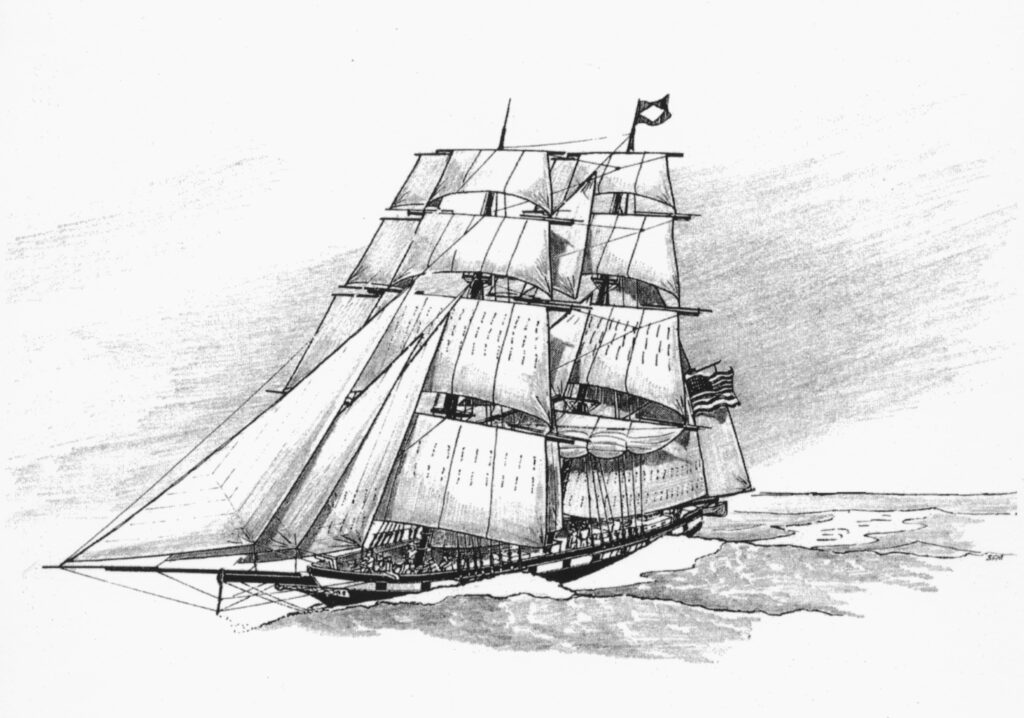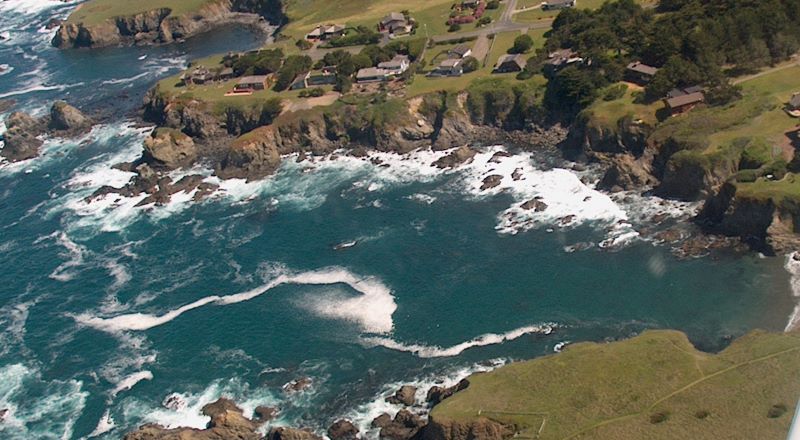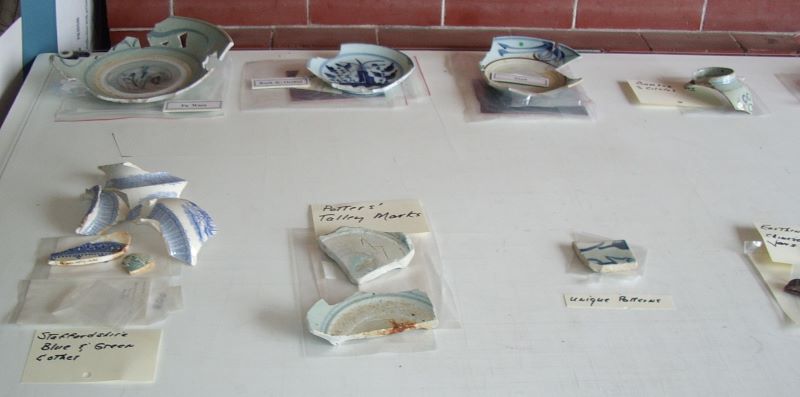The Frolic Beer Story
This article is reproduced courtesy of the author Bruce Rogerson, Point Cabrillo Lightkeepers Association, and The Annual Journal of the Scottish Brewing Archive Association, Edinburgh, Scotland.
The China Connection
On a summer evening in the mid nineteenth century, a light fog layalong the rugged coast of California, A group of native Americas of the local Pomo people were gathered on the bluffs above the roaring surf of the Pacific Ocean. Looking out to sea, they saw a ghostly sight as a large square rigged ship under full sail appeared out of the mist. They watched in amazement as the ship suddenly turned to avoid the breaking surf on a reef several hundred yards away. Over the roar of the ocean they heard the sound of tearing wood and the shouts of the ship’s crew. She started to go down by the stern and list as she wallowed in the ocean swells.

Next morning the Pomo were surprised to find the ship still afloat and being maneuvered using her sails and assisted by two ships boats towing her into the cove below their camp site. By late in the day, the vessel was anchored close in shore, the hull resting on the bottom of the cove. They watched some crew board the two ships’ boats and row off into the fog leaving a few Malay and Lascar to unload food and supplies on to the nearby beach. It was not long before the Pomo men swam out to the wreck to see what they might salvage for themselves.
Over the next several weeks, more and more of her cargo was collected by the Pomo, as it washed ashore: Baskets of pottery, fine china, flatware, rolls of silk and furniture. Amongst the jetsam and flotsam were also several iron bound wooden cases which on opening the Pomo found dozens of corked green log-necked bottles containing a brown liquid with a slightly bitter flavor. Soon the bottles were being shared around the camp and more than a few of the Pomo became a little tipsy. Maybe their first taste of beer!
Our story jumps forward to the summer of 1984 on a ridge in the redwood forests of Mendocino County, California between the Village of Mendocino and the old logging town of Willits, one hundred and seventy-five miles north of San Francisco. Doctor Thomas Layton and three of his archaeology students form San Jose State University are about to start the investigation of a native American village site on Three Chop Hill thought to have been occupied well into the 19th century by members of the Mitom Pomo.
Spread across the hillside just below the ridge line are several circular depressions indicating where the conical redwood dwellings of the Pomo were located. Carefully, the students started to remove the covering of redwood needles and tan oak leaves from one of the sites and sift through the first layers of soil. From previous excavations of Pomo village sites, they expected to find evidence of the occupation including stone tools made of obsidian and chert and perhaps arrow heads fashioned from chert. As they sifted through the detritus in the depressions, they found the expected chert arrowhead and obsidian flakes, but on the next sift of soil, several tiny fragments of what looked like pottery and several slivers of green bottle glass were discovered.
Later in the summer, the excavations of several more of the circular hut sites was undertaken by the students and these uncovered more fragments of pottery with traces of oriental designs and additional small pieces of green bottle glass. Several of the pieces showed evidence being flaked and ground by the Pomo.
Dr. Layton’s first thought the pottery had come from earlier contact by the local Pomo with a Spanish Manila Galleon in the 16th/17th century, as those vessels made landfall from the Philippines along the Mendocino Coast on their way to ports in Mexico. However, after showing the items found in the Pomo hut sites to a local forest ranger, he was told of reports of unusual findings of pottery in a cove on the coast near the village of Mendocino, possibly from a “sampan”. This led Dr. Layton to the Kelley House Museum and to contact with a local diver.
Diver David Buller had donated items from a wreck to the Kelley House Museum in 1979 and showed Dr. Layton some examples including complete porcelain bowls, flatware, ship fittings and filigree gold jewelry. In addition, he had researched local papers and in the Alta Californian, a leading paper in the mid nineteenth century, and found a report on a recent ship wreck on the Mendocino Coast. This report identified the ship as the Clipper Brig “Frolic”, Edward Faucon, Captain, the date of the wreck July 25th, 1850 and the cargo from China bound for San Francisco. A library search found references to the Frolic in a book on the Opium Clippers.
The Kelley House Museum also provided a report of an attempt by Jerome Ford from Bodega Bay to locate the site of the wreck in the summer of 1851. He did not find salvage of any value but did report seeing Pomo women wearing silk shawls taken from the wreck. Salvaging anything from the Frolic was soon forgot by the sight of huge stands of Redwood trees and Douglas fir stretching along the coast and many miles into the interior. Within a year the first lumber mill was established a few miles from the wreck site marking the start of the lumber industry on the coast of Mendocino.
Over the next few years Dr. Layton completed extensive research of archives in libraries and universities in California and on the east coast, piecing together the history of the Frolic and her owners, August Heard and Company of Boston. The Frolic was built in Baltimore in 1844 by Gardner Brothers and sailed for Bombay India, December 8, 1844 in ballast as her owners could not find a suitable cargo in Baltimore for Bombay, India. After sailing down the South Atlantic she rounded the Cape Of Good Hope and headed for the India Ocean and Bombay where she arrived on March 28, 1850 after 109 days at sea with a best day of 245 miles, but many days becalmed in equatorial waters.
From 1845 to 1849, under the Command of Captain Edward Faucon, Frolic successfully traded between Bombay on the west coast of India to south China ports carrying chests and bales of dried opium, then a semi legal trade sanctioned by the British Raj. A catastrophic dismasting in a typhoon off Hong Kong in the fall of 1849, the advent of steam powered vessels in the trade and a decline in the available opium cargoes, forced her owner and agents to look elsewhere for a suitable cargo.
In June 1850, the Frolic loaded a cargo at Canton, China. News of the gold discoveries in California in 1848 was well known in China by then. Captain Faucon, and the owner’s agent, decided to purchase a cargo of Chinese merchandise to be loaded on the Frolic and carried across the Pacific to San Francisco where such a cargo would attract a good price in the newly prosperous and expanding metropolis by the Bay. Included in this valuable cargo were bales of silk, fine pottery and china, furniture, a prefabricated house and 6,108 bottles of Edinburgh ale.. The Frolic sailed on June 10, 1850 on her ill-fated voyage to San Francisco following the ancient route of the great Manila Galleons, taking advantage of the prevailing “los vendavales” as the Spanish sailors called them, the strong southwesterly winds across the north Pacific Ocean.
On the evening of July 25, 1850, the Frolic’s lookout spotted the white loom and heard the roar of breaking surf ahead. Despite valiant efforts by the Captain and crew to ware the ship round and beat off the lee coast, the stern of the Frolic was flung against a rock by a breaking swell, flooding the cargo hold and crew spaces.

As the ship foundered, items of cargo floated free and much came ashore along the cove and surrounding shoreline. The cargo salvaged by the Pomo made its ay inland to their winter camp on Three Chop Ridge including Chinese pottery and green bottle glass which the Pomo used as a resource as tools and decoration for jewelry. The Pomo were known to trade with inland tribes across Northern California and items of pottery and glass may have made their way to other Native American tribes. The Pomo also traded items from the Frolic with white and Latino settlers and early recollections and accounts by ranchers tell of Indian women trading bolts of Chinese silks, and of large Chinese vases being seen in early adobes inland in Mendocino county.

The beer carried on the final voyage of the Frolic was originally acquired by Heards in Canton contained in 24 hogsheads (large barrels) and subsequently decanted into 599 dozen log necked green bottles at a cost of 30 cents per dozen. The 6,108 bottles were then packed in iron bound cases at six dozen bottles per case for a total of 84 cases of beer. The cases of beer were loaded aboard the Frolic at Hong Kong where the bottling took place.
The bill of sale for the 24 hogsheads described the contents as Edinburgh ale but there is no documentation found that could identify which brewery in Edinburgh the beer might have come from. In the mid nineteenth century, Wm. Younger & Cos were major exporters of beer from their brewery in Edinburgh and there are records that they had an Edinburgh Ale. It is not known if they shipped beer to international markets in hogsheads. Their India Pale Ale, was specially developed to withstand the long voyage to the Far East through the tropics, but this trade was mostly in bottled form, not in hogsheads. Unfortunately, none of the long necked green bottles of the Edinburg ale survived to modern times from the wreck which might have allowed an analysis of the beer and possible identification of its origin.
In the 1990s the whole story was coming together and a series of exhibits were being set up at museums in Mendocino County. A casual meeting, in a bar in Hopland, Mendocino County, between Richard Everett, Curator of Exhibits at the Maritime Museum San Francisco, who was assisting with exhibits, and a brewer with the Mendocino Brewing Company lead to the release of a Frolic Shipwreck Ale over two years on the anniversary of the wreck on July 25.

For the full story of the Frolic and its loss on the Mendocino Coast see the following two books:
The Voyage of the Frolic by Dr. Thomas Layton, Stanford University Press 1997
Gifts from the Celestial Kingdom by Dr. Thomas Layton, Stanford University Press 2002
